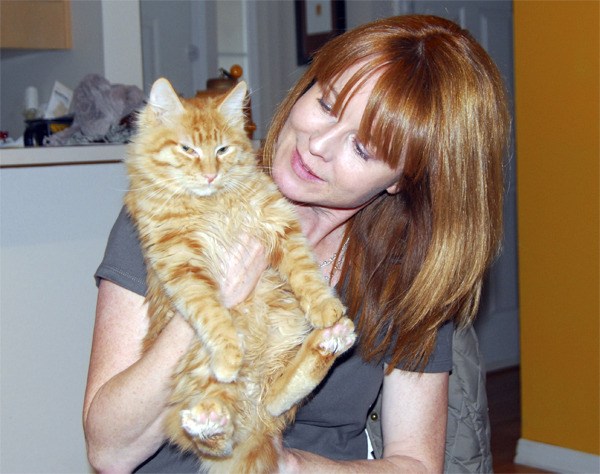The Forest Hunter cattery has all the equipment you’d expect to find in a cat-breeding program. There are little-used kennels, well-abused scratching posts, kitty drinking fountains, plenty of toys, and cats and kittens of all sizes. Two of them are lying in ambush outside a cupboard door, waiting for their victim to poke his head out. Another is snuggled into the bottom shelf of an end table. Every few minutes a small parade of fluffy kittens whizzes by, the one in the lead trying to keep whatever treasure it’s found from the pursuers.
“I call that the fur blur,” says owner Konnie Surmann, watching the race. Only they’re not a blur to her. Surmann has 16 cats and she can instantly tell them all apart, and then tell you their stories.
“That’s RT Junior, he was born here, and this one is Rain. There’s Glory, my other female, and that one over there,” she points to an ancient black and white cat slowly making her way across the wood floor, “is Grandma.”
Grandma is a distinct minority in the household. Her story is that she was abandoned, and is at least 19 years old. She found Surmann near her Snoqualmie home, and Surmann took her in to live out the rest of her life. Surmann had been rescuing cats with organizations like MEOW (www.meowcatrescue.org) for years, long before 2003, when she fell in love with the Pixie Bobs she now breeds. Pixie Bobs—Pixie for the name of the first cat of the breed, developed about 25 years ago in the Pacific Northwest, Bob for their stubby tails—are big and fluffy, brown-spotted cats with huge paws and intelligent faces.
Even to non-cat lovers, they have appeal. Some of the most challenging feline traits, like yowling, being aloof, skittishness, and spraying, don’t exist in Surmann’s Pixies (although the breed has been known to produce males who spray). They follow her around like puppies, want nothing more than to sit in her lap, and have learned to open all of her cupboard doors, even with the child locks engaged.
“Pixie Bobs often use their feet like you would use your hands… they all know how to open doors,” Surmann said. “If I can’t find one, it’s usually in the kitchen cabinet, sleeping in one of my pots or pans.”
It sounds adorable, if unsanitary, but Surmann doesn’t mind giving the Pixies, mixed-breeds, and Kurilian Bobtails she just started breeding, free run of most of her home, because she has a strict rule that no cats are allowed in her bedroom. As for the countertops and surfaces in the rest of the house, she says, “Bleach is your friend. Use it!”
Surmann maintains a rigorous cleaning schedule at home, especially for the half-dozen litter boxes set up in a spacious pantry accessible by kitty door, and is very specific about the litter she uses—corn based for kitten safety.
She also has strict rules about how often and when to breed her cats, and when to retire them. Currently, she has two males and two females who are of breeding age, and one male and female that are almost there. By the end of the year, both female Pixies will have had four litters, and both males will be approaching age 3, time for all of them to be spayed or neutered, and retired as pets to families who’ve been waiting for them.
Kittens can’t go to new homes until they are three months old, with all immunizations current, spayed or neutered. Before anyone can adopt one of Surmann’s cats or kittens, though, they must apply and, if selected, commit to a seven-page contract regarding the care and well-being of their kittens or cats.
Everything Surmann does is for the betterment (and love) of the breed. She does have one goal that isn’t entirely selfless, however: The International Cat Association (TICA) she belongs to names a Cat of the Year every summer, “and there has never been a Pixie Bob Cat of the Year,” said Surmann. “I want to breed the first Pixie Bob to win Cat of the Year.”
For more information, visit www.foresthunter.com.



